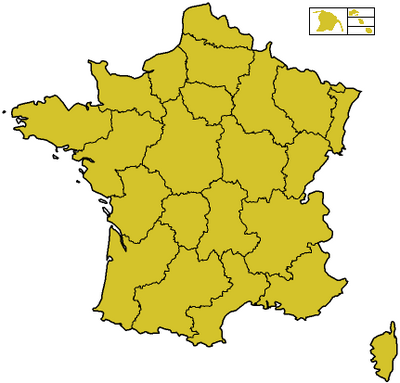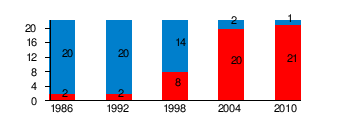Regions of France

 |
|
This article is part of the series on
Administrative divisions of France |
|
Regions
(incl. overseas regions) |
|
(incl. overseas departments) |
|
Urban communities |
|
Associated communes |
|
Others in Overseas France
Overseas collectivities |
France is administratively divided into 26 regions (French: régions), of which 22 are on Metropolitan France, and four are overseas. Corsica is a territorial collectivity (French: collectivité territoriale), but is considered a region in mainstream usage, and is even shown as such on the INSEE Web site.[1] Each mainland region and Corsica are further subdivided into two to eight departments.
The term "région" was officially created by the Law of Decentralization (2 March 1982), when by the same act their legal status was conferred. The first direct regional elections for representatives took place on 16 March 1986.[2]
Contents |
General characteristics
In mainland France (excluding Corsica), the median land area of a region is 25,809 km² (9,965 sq mi), which is just a bit larger than the state of Vermont, and only 4% as large as the median land area of a Canadian province, but 15% larger than the median land area of a German region ("Regierungsbezirk"), and 67% larger than the area of a region of England.
In 2004, the median population of a region in continental France was 2,329,000 inhabitants, which is a little less than one half of the median population of a region of England, and three quarters of the median population of a German Land (state), but more than twice the median population of a Canadian province.
Role
Regions don't have separate legislative authority and cannot therefore write their own statutory law. They levy their own taxes and, in return, receive a decreasing part of their budget from the central government which gives them a portion of the taxes it levies. They also have considerable budgets managed by a regional council (conseil régional) made up of representatives voted into office in regional elections.
A region's primary responsibility is to build and furnish high schools. In March 2004, the French central government unveiled a controversial plan to transfer regulation of certain categories of non-teaching school staff to the regional authorities. Critics of this plan contend that tax revenue is insufficient to be allocated to pay for the resulting costs and such measures would increase regional inequalities.
Apart from these legal attributions, regions have considerable discretionary powers for infrastructural spending, e.g., education, public transit, funding universities and research, and assistance for business owners. Because of this, being the regional head of a wealthy region such as ĂŽle-de-France or RhĂ´ne-Alpes can be quite a high-profile position.
Occasional discussions about giving limited legislative autonomy to the regions remain controversial. There are also proposals to transfer certain local government powers of the departments to their respective regions, leaving the departments with very limited authority.
Regional Control
Number of regions controlled by each coalition since 1986.
Red: left, blue: right

Regions and their capitals
| Flag[3] | Region | French name | Native Name(s) | Capital | INSEE No.[1] | Notes |
|---|---|---|---|---|---|---|
| Alsace | Alsace | Alsatian: ElsĂ ss; German: Elsass | Strasbourg | 42 | Takes its name from the former German territory of ElsaĂź. | |
| Aquitaine | Aquitaine | Occitan: AquitĂ nia; Basque: Akitania | Bordeaux | 72 | Takes it's name from the former Roman Province of Aquitaine which includes Guyenne and Gascony. | |
| Auvergne | Auvergne | Occitan: Auvèrnhe / Auvèrnha | Clermont-Ferrand | 83 | Takes its name from the province of Auvergne | |
| Burgundy | Bourgogne | Burgundian: Bregogne ou Borgoégne; Franco-Provençal: Borgogne | Dijon | 26 | Takes its name from the Duchy of Burgundy | |
| Brittany | Bretagne | Breton: Breizh; Gallo: Bertaèyn | Rennes | 53 | Takes its name from the Duchy of Brittany | |
| Centre | Centre | Orléans | 24 | Takes its name from its position in France | ||
| Champagne-Ardenne | Champagne-Ardenne | Châlons-en-Champagne | 21 | Takes its name from the former Province of Champagne. | ||
| Franche-Comté | Franche-Comté | Franc-Comtois: Frà ntche-Comté; Franco-Provençal: Franche-Comtât | Besançon | 43 | Takes its name from the Free County of Burgundy (Franche Comté in French) | |
| Île-de-France | Ile-de-France | — | Paris | 11 | Takes its name from the province of Ile-de-France, but also includes parts of Champagne | |
| Languedoc-Roussillon | Languedoc-Roussillon | Occitan: Lengadòc-Rosselhon; Catalan: Llenguadoc-Rosselló | Montpellier | 91 | Takes its name from the provinces of Languedoc and Roussillon | |
| Limousin | Limousin | Occitan: Lemosin | Limoges | 74 | Takes its name from the province of Limousin, but also includes parts of Marche, Berry, Auvergne, Poitou, and Angoumois | |
| Lorraine | Lorraine | German: Lothringen | Metz | 41 | Takes its name from the province of Lorraine (itself a part of the ancient German Stem duchy of Löthringen) but also includes the Barrois and the Three Bishoprics | |
| Lower Normandy | Basse-Normandie | Norman: Basse-Normaundie | Caen | 25 | ||
| Midi-Pyrénées | Midi-Pyrénées | Occitan: Miègjorn-Pirenèus or Mieidia-Pirenèus | Toulouse | 73 | Artificial region, with no historical links, created as a region for Toulouse | |
| Nord-Pas-de-Calais | Nord-Pas-de-Calais | Dutch: Noord-Nauw van Kales | Lille | 31 | Takes its name from the departments of Nord and Pas de Calais | |
| Pays de la Loire | Pays de la Loire | Breton: BroioĂą al Liger | Nantes | 52 | Artificial region, with no historical links, created as a region for Nantes | |
| Picardy | Picardie | Amiens | 22 | |||
| Poitou-Charentes | Poitou-Charentes | Poitiers | 54 | Takes its name from the former French Province of Poitou | ||
| Provence-Alpes-Côte d'Azur | Provence-Alpes-Côte d'Azur | Occitan: Provença-Aups-Còsta d'Azur (Classical norm) or Prouvènço-Aup-Costo d'Azur (Mistralian norm) | Marseille | 93 | The region comprises mostly of Provence and includes the former County of Nice, Principality of Orange and Avignon territories. | |
| Rhône-Alpes | Rhône-Alpes | Franco-Provençal: Rôno-Arpes; Occitan: Ròse Aups | Lyon | 82 | Artificial region broadly based on the provinces of Dauphiné and Lyonais, created as a region for Lyon | |
| Upper Normandy | Haute-Normandie | Norman: Ĥâote-Normaundie | Rouen | 23 | ||
| The following region has a special status, that of Territorial collectivity. | ||||||
| Corsica | Corse | Corsican: Corsica | Ajaccio | 94 | Territorial collectivity | |
| The following four regions have a special status, that of Overseas regions. | ||||||
| Guadeloupe | Guadeloupe | Antillean Creole: Gwadloup | Basse-Terre | 01 | Overseas region | |
| Martinique | Martinique | Antillean Creole: Matinik | Fort-de-France | 02 | Overseas region | |
| Reunion | La RĂ©union | Reunion Creole: La RĂ©nyon; | Saint-Denis | 04 | Overseas region | |
| French Guiana | Guyane | Cayenne | 03 | Overseas region | ||
See also
- Regional councils of France
- Administrative divisions of France
- Ranked list of French regions
- French regional elections, 2004
- Flags of the regions of France
- ISO 3166-2:FR
References
- ↑ 1.0 1.1 "Carte des Régions" (in French). INSEE. http://www.insee.fr/fr/methodes/nomenclatures/cog/carte_regions.asp. Retrieved 2009-09-29.
- ↑ Jean-Marie Miossec (2009), Géohistoire de la régionalisation en France, Paris: Presses universitaires de France ISBN 978-2-13-056665-6.
- ↑ These flags are not official, but popularly used.
External links
- (English) Regions of France at the Open Directory Project
- Guide to the regions of France
- Local websites by region
- Maps of France
- Useful information on France
- Will 2010 regional elections lead to political shake-up? Radio France Internationale in English
|
||||||||
|
||||||||